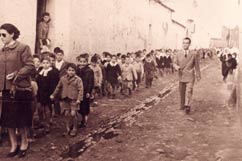Thanks to the testimonies collected by interviewing the elderly of the town, it has been possible to know the old look of the homes. During the years, they have been modified above all because of the frequent floods.
Most of the houses, were made of mud and straw (lardini), they were very small and gave hospitality just to one big family (about ten members):
- a room for women
- a room for men when it was possible (otherwise they slept in the kitchen on some mats)
- a big kitchen, often with a fireplace in the middle.
Outside, instead, there were:
- a bathroom called “muntronaxiu” that consisted of a little space, in a corner of the garden, protected by some canes
- the manure-heap, in which where thrown away the excrements and all the domestic rubbish
- a wood-burning oven
- a well

The rooms were arranged in row and the windows were oriented to east, to the sun. All the houses had a courtyard with just an entrance, usually formed by a wood gate, called “ecca”.
In the houses with a big courtyard there was “sa domu de palla” (the hayloft) where was usually kept the forage; moreover the courtyard was generally used for some animals (hens, gooses, rabbits, ducks, etc.) and there was also a room for the horse or a space for oxen. Sa lolla, that is to say the arcade, there was just in the house of rich families.
The streets of the town were not asphalted, were uneven and stony and the gutter were in the middle. During the winter, the streets became muddy bogs and the water flowed in their middle.
There were drinking trough for the horses (typical means of transport of that time), that, during the small stops of their owners, were fastened to rings which were in the external walls of the houses. The first asphalted street dates from 1953.
